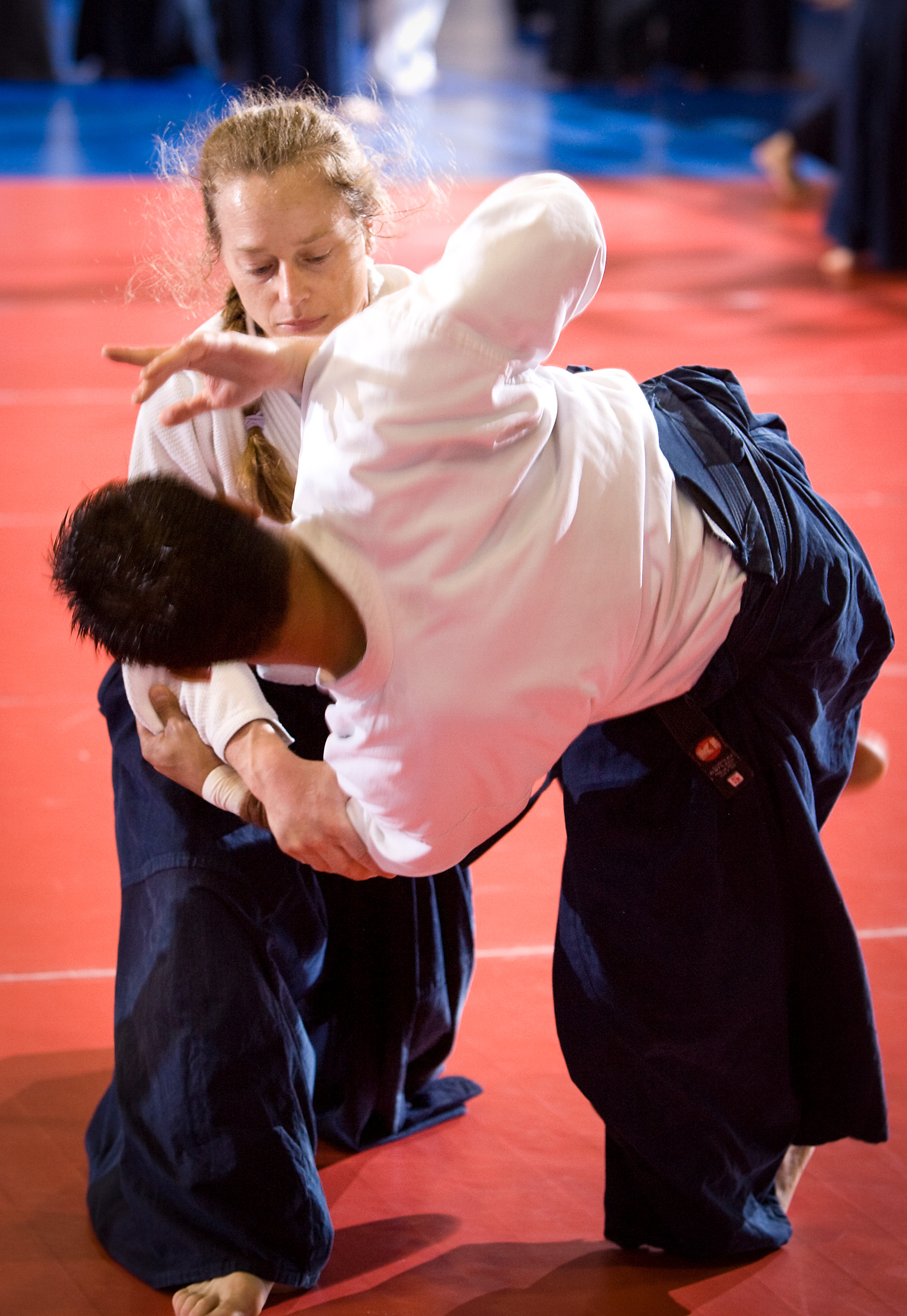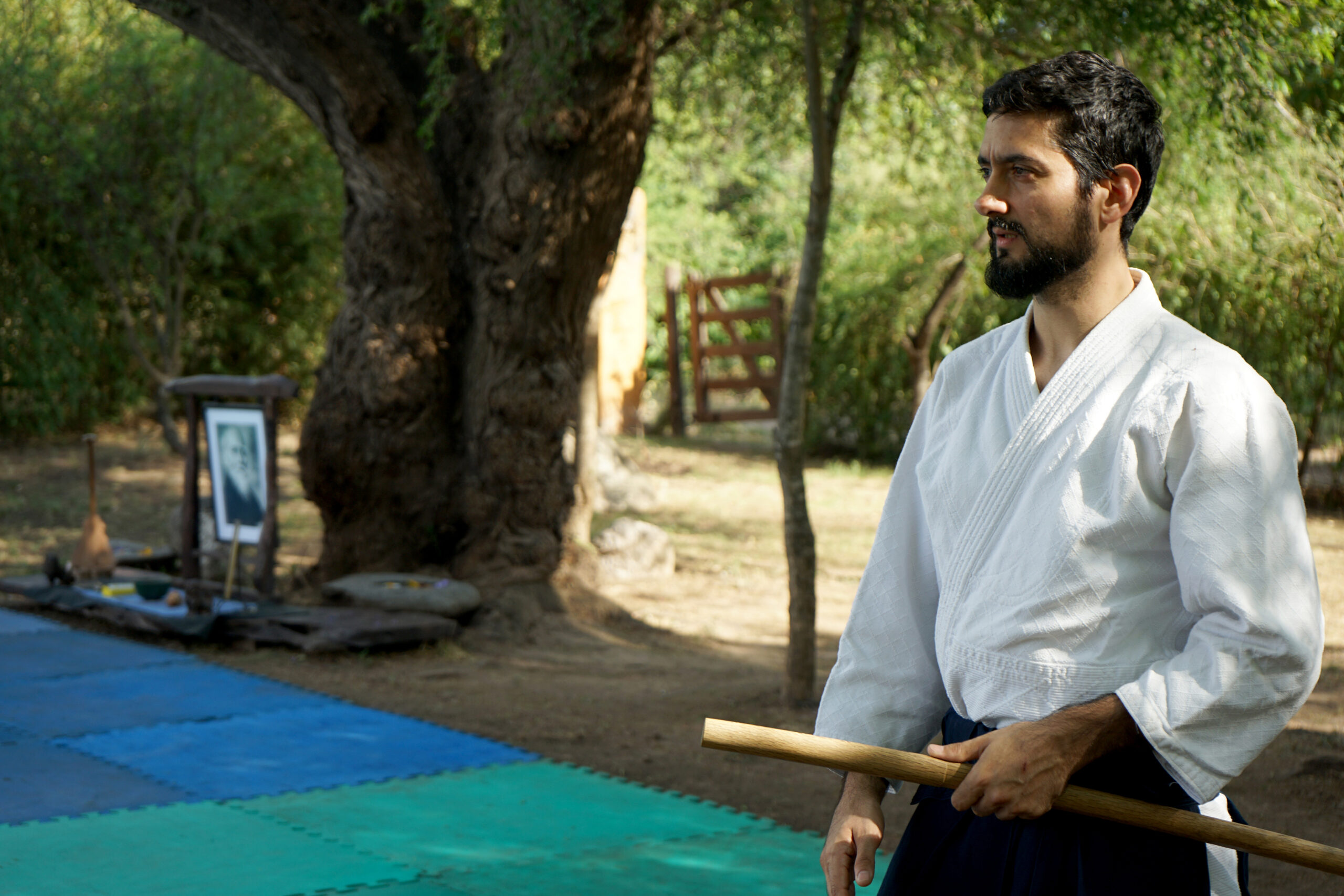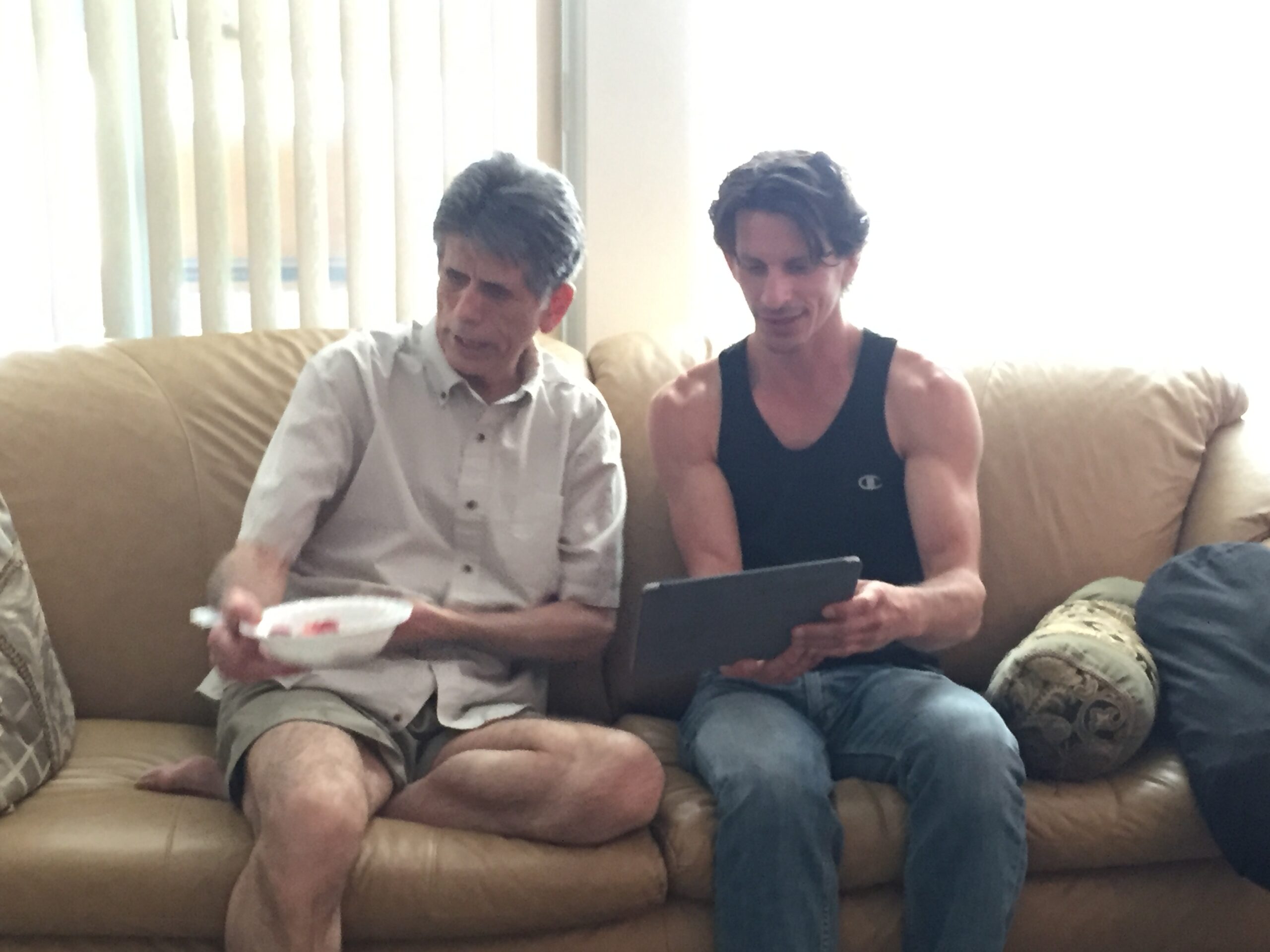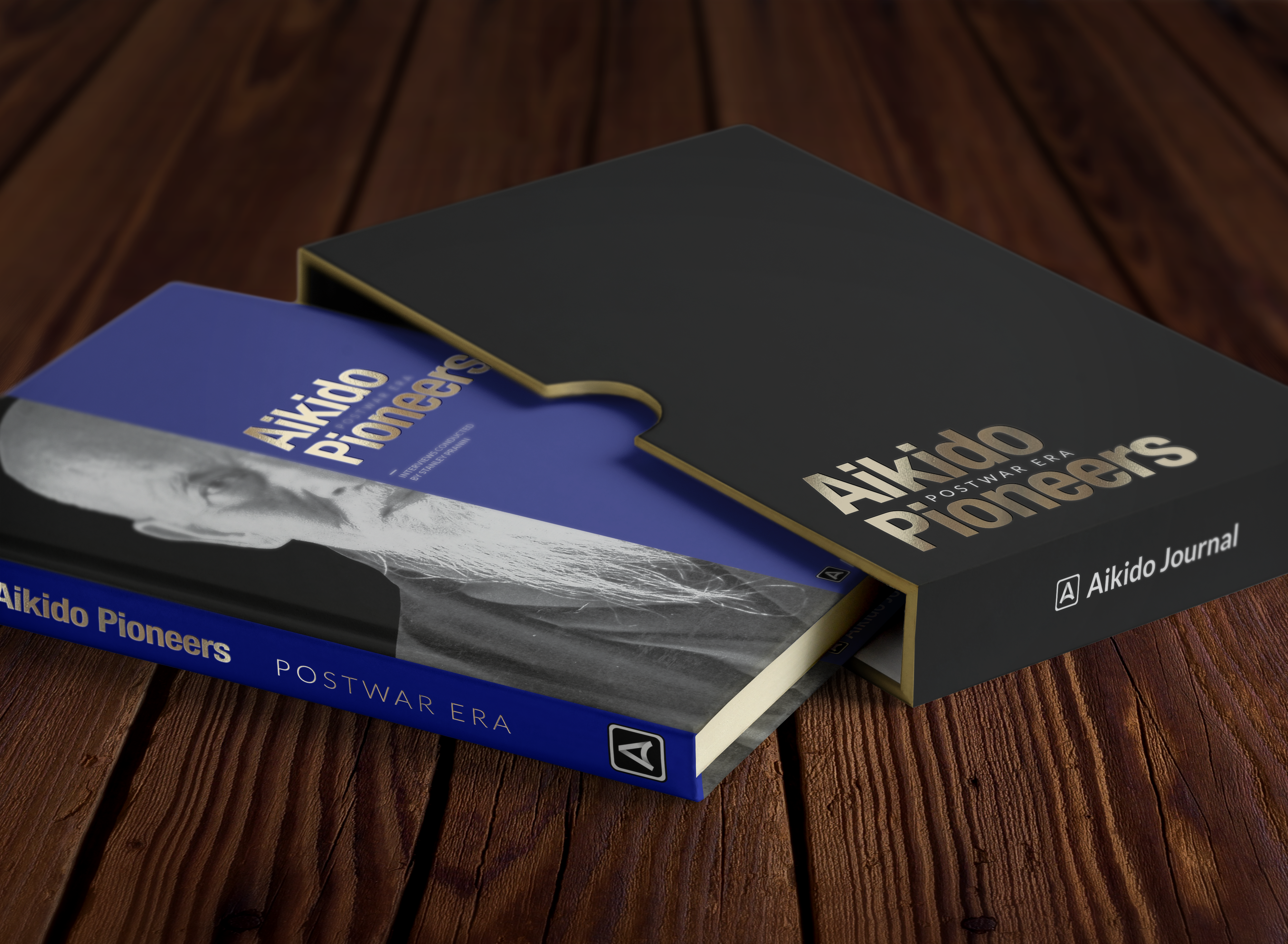A unique collaborative effort led to the creation of an extraordinary limited edition publication – Aikido Pioneers: Postwar Era – the product of 30 years of research by Stanley Pranin, founder of Aikido Journal. We’re pleased to bring you an interview with the team responsible for this new, limited edition book. Join us as we explore the journey behind creating this tribute to aikido’s early visionaries, and shed light on the challenges and inspirations that shaped this ambitious project.
Roo and Mario, can you please share a bit of your background relevant to this project?
Roo Heins: In the editing world, I’m known as Catherine; in the aikido and martial arts world, I’m known as Roo. I started practicing aikido in 1995 and have trained iaido since 1996. My first teacher was Kazuo Chiba Shihan. In 1999, I moved to San Diego to study with Chiba Sensei and was there until 2004. Then I moved to Tokyo and began studying at Hombu Dojo under Doshu Moriteru Ueshiba. While I was in Japan, I started editing professionally. I found a niche in editing books related to Japanese martial arts, tourism, education, culture, history, and even cookbooks. I have a background in linguistics, classical languages and history, so I was predisposed to this, I suppose.
I also have my own dojo, Mitsubachi Dojo, in Kalamazoo, Michigan where I teach aikido and iaido.
Mario Sapienza: I am from Buenos Aires, Argentina. I’m a graduate of the graphic design program at the University of Buenos Aires. I have over 10 years of experience in editorial design. I’m also a shiatsu therapist. I’ve practiced aikido for almost 20 years and have travelled to Japan twice for aikido. I have my own dojo, as well, and we recently we celebrated our eighth anniversary.
Where did the nickname “Roo” come from?
Roo: It was a childhood nickname. My parents used to read us, Winnie-the-Pooh, and I’m the youngest, and I was rather animated as a child, so I was baby Roo and my mom was Kanga. My mom wanted to call me Katie, and I put up with it for 11 years. Then when I was 12, I said, “No. No more. Everybody call me Roo or don’t call me.” So that was it. Ever since then, I’ve been called Roo.

Why were you interested in working on this project?
Mario: It was a challenging project that combined two of my greatest passions. I also personally wanted to have a beautiful book that would create a great experience when I read or study about aikido. I also wanted to share that experience with the readers of Aikido Journal. Working on this project was really a dream come true for me.

Roo: I love the martial arts, and as a professional editor, I get very frustrated with a lot of martial arts books because they’re not well-edited. There’s good content, but sometimes it gets lost in poor phrasing. I also appreciate a well-laid-out, well-designed martial art book and wanted to be involved in creating something truly special for the aikido world. I really feel Mario’s work is so important, and I wish more people emphasized it as he does, because it truly makes the reader’s experience so much better.
“I feel that as students of various masters, we get in our own little tunnel and we see aikido that way. Working on these interviews really opened my eyes to the vast kaleidoscopic vision of aikido that we get from all these different disciples of O-Sensei. It’s just a treasure. It’s an absolute treasure.”
The material in this book is so incredibly important, I wanted to make sure it is presented in a way that readers could access. More fundamentally, I feel Stan Pranin is a hugely important figure in aikido history in the West. He did as much as anyone I can think of to synthesize the ideas behind aikido, and to connect the West to Japan, in a bi-directional way. He wasn’t just bringing information to us. I saw him again and again in these interviews asking thought-provoking questions: “What are you guys doing about international representation? What are you guys doing about the problem of weapons in aikido? What’s your perspective on this?” He had his own passions. After he was gone, I see the body of his work is just this immense thing that I didn’t want to lose.
Also, I feel that as students of various masters, we get in our own little tunnel and we see aikido that way. Working on these interviews really opened my eyes to the vast kaleidoscopic vision of aikido that we get from all these different disciples of O-Sensei. It’s just a treasure. It’s an absolute treasure.
Josh: For me, this was an opportunity to do something to honor Stan Pranin. Stan had basically finished this book, but wasn’t able to publish it before he passed away. It’s incredibly important work that he dedicated decades of his life to. I wanted to bring the book to life in a way that represented the quality and importance of the content. At the same time, I wanted to create something beautiful for the Aikido community; something we can be proud of.
“The material in this book is so incredibly important, I wanted to make sure it is presented in a way that readers could access. More fundamentally, I feel Stan Pranin is a hugely important figure in aikido history in the West. He did as much as anyone I can think of to synthesize the ideas behind aikido, and to connect the West to Japan, in a bi-directional way.”

Tell us about your roles on the project and how you approached them.
Roo: I was the editor of the book. The bigger decisions were related to consistency of voice and presentation, because that was all over the place. Over 30 years, of course, you’re doing these one-off interviews and you don’t look at the bigger picture and ask, “Did I do this the same every time?”
I didn’t want to mess too much with the content. I fixed obvious errors and I tried to do away with some redundancy. I wanted to ensure the interviews flowed well. These things were in Japanese originally and they’ve been translated, so I felt a fair amount of license to rework the language to make it clearer when it was obvious there was a clunky translation in the first place. But I also wanted the teachers to say what they said, whether it made them look good or not. Because I feel like this is a snapshot in time, and all of these teachers evolved past the point of their interview. I think readers need to remember that this isn’t how they were forever. They all kept changing.
Josh: I was the executive editor, so I mostly saw my role as bringing together a great team for the project, and making sure we created the best expression of Stan’s work. One thing that came up a few times is which interviews are included in the book. Some people contacted me and asked, “My Sensei was a direct student of the founder and post-war, so why aren’t they in the book?” I know that there are some amazing masters who didn’t end up in the book who could have been in there, but Stan did the interviews and created the manuscript. He decided which interviews were going to be in there. I know that he had wanted to interview some people and was unable to, and there were others who were interviewed by Aikido Journal but not included. I didn’t think it was my place to change Stan’s work. I didn’t know what his thought process was, so I was very careful not to mess with that.

Mario Sapienza: I was the graphic designer, and in that frame, the first task was thinking about the user experience. I asked myself, “How would I like that experience for me? The first big decision was the format. We decided on a coffee table format book – a large book that would be read over time. There is so much important material and it takes a long time to digest it. We had to design the form factor in a way that lends itself to what the reading experience should be like.
Josh: I think the layout and form factor are so important. I started Aikido in 1991. I still have a bunch of books from the early nineties that I bought. They’re paperback and don’t have the best design and layout, but I still have them on my bookshelf today. I imagine that people are going to have this book on their bookshelves for decades moving forward, so I’m happy we created something that’s well crafted. I think it’ll stand the test of time.
Roo: The way Mario designed the book makes it very accessible. I think the pullquotes and the amount of open space on the pages is brilliant as far as a context for making this information available and accessible to everyone. Someone who doesn’t know anything about aikido might come to it and just find it beautiful. On the other hand, nerds who love aikido and know a lot about it are going to find something new and just really devour all the photos and the pullquotes.

What was the biggest challenge for you on this project?
Roo: Editors are consistency fiends. We are all about consistency, because everything is done in the service of the comfort of the reader. You want the reader to feel comfortable, you want them to have faith in the material that they’re reading. Inconsistencies tend to unconsciously shake the faith of the reader and make them uncomfortable.
That’s a real challenge. Even if the material is fantastic, you’ve got to pay attention to this very bread-and-butter issue of things like italicization. I started out italicizing every instance of a Japanese word that was not in Merriam Webster, which that’s the standard treatment per Chicago Style. But some houses like Kodansha back when they did English books, their policy was you italicize the word on first mention in the chapter, and then thereafter it’s rendered not italic, in Roman. That was what I ended up going with, because italics can kind of clutter up a text; they can distract from the content. Because we were dealing with a lot of Japanese terms, I didn’t want to italicize uchi deshi every time it came up. By the time you read that book, you know what uchi deshi is. Those things may seem like minor details or are maybe not even consciously noticed by the reader but are very important to having consistency.
“This is a hugely important book for practitioners at all levels. For people who are newer to aikido, I think it is really important to have a historical context for the art you’re studying. It has a very deep philosophy behind it, and the disciples of O-Sensei adhered to that – at least the ones in this book really followed his philosophy in their own way.”
Mario: Getting the layout right for a book like this was really tough, but since we figured that out during the Prewar Pioneers book, we could focus on refining and making improvements to something that worked very well.
But in this book, it was a real challenge to work with the photos. The quality of the images was quite inconsistent, and because we need to print them in large format – it is quite different from website or screen resolution. It was really challenging to retouch and clean the images. But I’m happy that I was able to smooth or sharpen some amazing photos. Maybe this will be my little legacy in aikido history.
Josh: For me, the challenges were not that great. Because our team worked together on a previous project, there was a lot of trust. We have a great designer, we have a great copy editor, and we have a great printing partner as well.
Still, there were a a few unforeseen challenges, so for me, the biggest challenge has been managing the timeline. We had unexpected factors that impacted the timeline in regards to design, printing, shipping, and fulfillment. I remember years ago, a friend who works in the video game industry told me: “Nobody will remember if your game was late, but everybody will remember if it was bad.” I wish we could have gotten the book in people’s hands a few months earlier, but I think a year from now, two years from now, people are not going to care that it was a few months late. But if the quality wasn’t there, that’s forever. We’re also fortunate in that the early backers of this project have been very patient and understanding as we’ve moved the project from concept to completion.

What do you think is the most special thing about this book?
Mario: It is an opportunity to get more information and more pieces of that puzzle that represent Morihei Ueshiba, the founder of aikido, out there to the aikido community. If you love aikido, you need to read this because there are a lot of things you may not know.
Roo: This is a hugely important book for practitioners at all levels. For people who are newer to aikido, I think it is really important to have a historical context for the art you’re studying. It has a very deep philosophy behind it, and the disciples of O-Sensei adhered to that – at least the ones in this book really followed his philosophy in their own way.
If you’re going to train in aikido, I think you should try to understand that deeply- and not just your own teacher’s philosophy, but understand that there was a bigger philosophy that was manifested in different ways by different teachers. Everyone had their own approach. And I think it’s inspiring to see that every one of the people in the book have this unshakeable faith in aikido.
Josh: I suppose the most special thing about the book to me was the experience of bringing it to life. I think Stan would be proud of the book, and I think we did something good for the art of the Aikido. Thanks to our awesome team, and to the aikido community, especially the early backers who supported getting the project kickstarted. I’m looking forward to getting the books in people’s hands soon.
Aikido Pioneers: Postwar Era is now available for purchase. We expect this limited edition to sell out quickly, as did the Prewar Era book. If you’d like a copy for your collection, now is the time to acquire one.













Well done, all of you who brought Stan’s final project to fruition.
I have a collection of many of Stan’s publications including Aikido Pre war Pioneers and some copies of the defunct Aiki journal magazine too.
ROO! We trained together at my Dojo in Kuala Lumpur in 2009. Remember?
Yes, the YMCA Dojo! Gosh, has it been 15 years already?
Hope you are well and doing fine in your Dojo.
All the best!
Yours in aiki,
Raymond Kwok
3.2.24